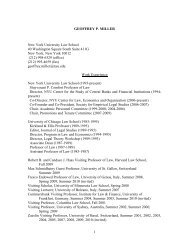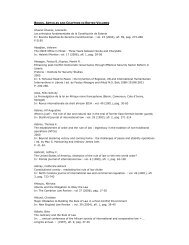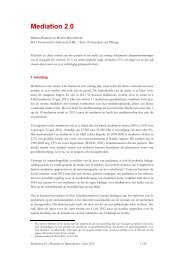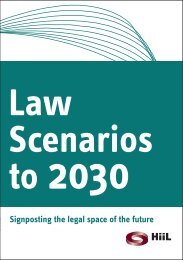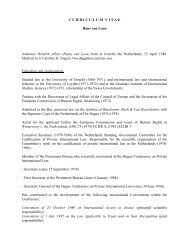Trend Report | Part 1 - HiiL
Trend Report | Part 1 - HiiL
Trend Report | Part 1 - HiiL
You also want an ePaper? Increase the reach of your titles
YUMPU automatically turns print PDFs into web optimized ePapers that Google loves.
The Changing Role of Courts<br />
The court hearing is now the focal point of civil procedures, with high expectations from all<br />
participants. Litigants want voice and procedural justice. The hearing is an opportunity for settlement.<br />
But it is also a venue for informing the judge about what happened and for debate about the legal<br />
merits. The Dutch council for the judiciary funded a number of projects in which 250 hearings have<br />
been monitored. Did the parties receive procedural justice, sufficient information and interpersonal<br />
justice (respect)? Who talked during the hearing for how long? How did the participants<br />
communicate? What, according to each participant, frustrates a good hearing? What are tools to<br />
make it go smoothly? Judges also experimented with different ways to manage the hearing.<br />
Cooperation or a battlefield?<br />
Respondents expect respect, voice, neutrality and a judge who listens to them and shows being<br />
involved. They are reasonably satisfied with the procedural justice they get. During the hearing, 32%<br />
of the cases are settled. Sometimes, participants feel pressed to do so. The results strongly suggest<br />
that this type of civil litigation is not seen as a battlefield. Even from their opponents, participants<br />
expect a positive attitude, respect, willingness to settle and submitting evidence in time. They see<br />
unnecessary accusations and qualifications as disturbances.<br />
Obstacles<br />
Disrespectful (non-) verbal communication was most frequently mentioned as disturbing behaviour.<br />
On average, each disturbance is associated with a 12 minutes longer hearing. Judges tend to react to<br />
disturbances by structuring the debate, rather than active listening or asking questions. Judges are<br />
often dissatisfied with the documents submitted to them. They tend to be irritated if a high number of<br />
ancillary issues and (weak) legal points are being brought up. Timing issues are another source of<br />
dissatisfaction.<br />
Suggestions for improvement<br />
The project results strongly suggest that hearings will be experienced as more fair and more effective<br />
if courts make clear what participants can expect. Guidelines or Q and A forms may help parties and<br />
lawyers to submit the most useful information in an organized way. Process descriptions or a video<br />
may work to give an impression of what will happen during the hearing. The practices for facilitating<br />
fair settlements can be improved as well.<br />
J. van der Linden & M. Barendrecht, Zitten, luisteren en schikken: Rechtvaardigheid en doelbereik bij de<br />
comparitie na antwoord, Research Memoranda, nr. 5-2008, Raad voor de rechtspraak, november 2008.<br />
M. Barendrecht, S. van Gulijk, M. Gramatikov, P. Sluijter, De goede procesorde in beeld, Research<br />
Memoranda, nummer 1-2011, Raad voor de rechtspraak, juli 2011<br />
On the other hand, there is the view that courts are providers of an authoritative interpretation of the<br />
law. If you go to a court, you may not get justice, but a better understanding of what the law says for<br />
your particular case. Appeals systems focusing on legal review and the culture of legal scholarship may<br />
support this perspective. In this view, judges are not trained in social work, economics or skills of dispute<br />
resolution. They should leave that to others. If judges work primarily for the law, their loyalty will not be<br />
so much towards clients, but to the legal system that is exemplified by appeals, supreme courts and<br />
legal treatises. Deciding cases rapidly is less of a priority (the law can wait a few more weeks) and<br />
whether the decision actually provides a workable outcome is not their responsibility. For the clients,<br />
these courts act as a kind of helpdesk where you can learn about the application of the law in your<br />
particular case.<br />
<strong>HiiL</strong> <strong>Trend</strong> <strong>Report</strong> – <strong>Part</strong> 1: Challenges and Promising Approaches 71






